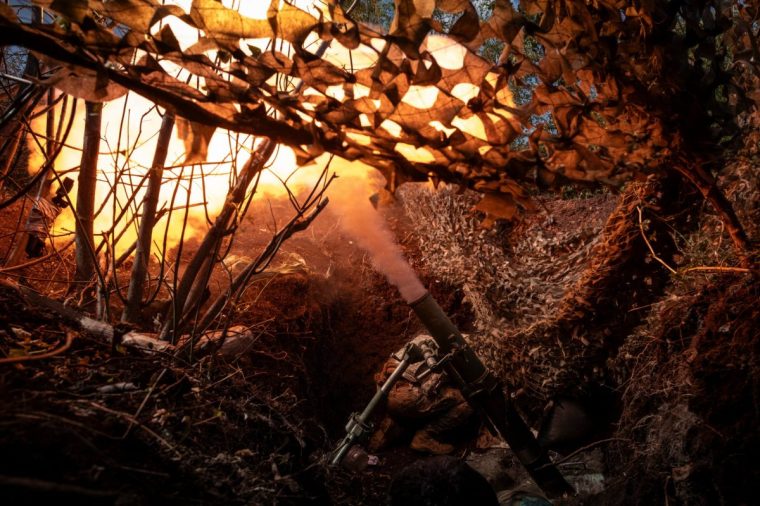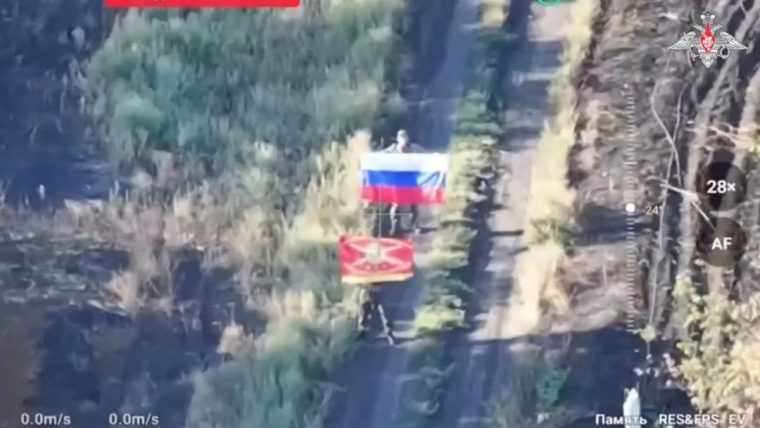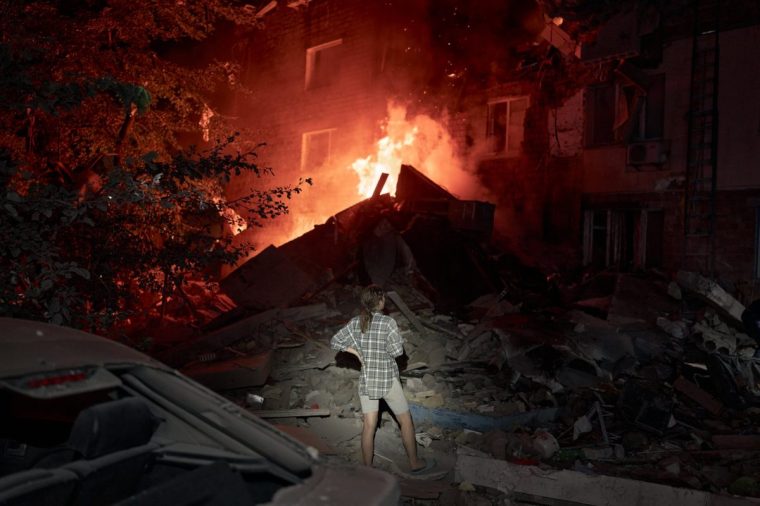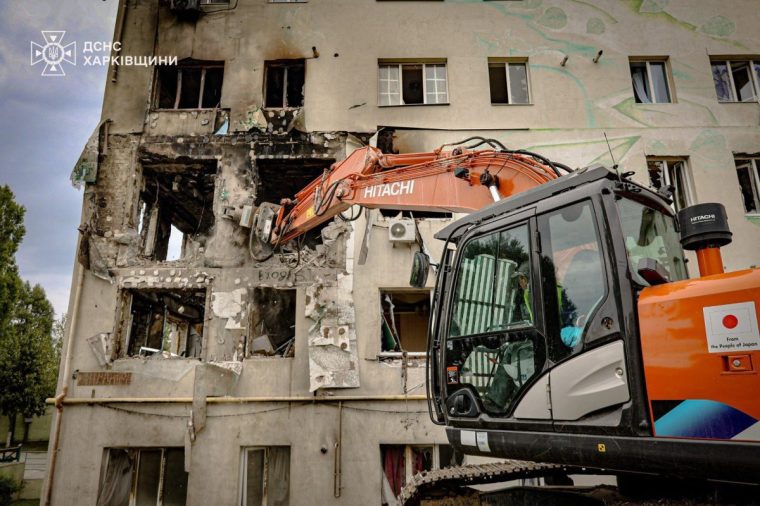Russia is escalating pressure on Ukraine with brutal missile attacks on its cities and major pushes on the battlefield as it tries to force Kyiv to capitulate to its war demands.
Moscow’s forces are capitalising on existing momentum on the eastern front to make incremental advances but Russia “does not hold all the cards”, analysts emphasised.
At least 12 people were killed in deadly drone and missile strikes on Kyiv overnight, in Moscow’s largest attack on the Ukrainian capital this month. The British Council building and headquarters of the European Union delegation in Kyiv were among structures hit in the attacks.
“These Russian missiles and attack drones today are a clear response to everyone in the world who, for weeks and months, has been calling for a ceasefire and for real diplomacy,” President Volodymyr Zelensky said. “Russia chooses ballistics instead of the negotiating table.”

The strikes come after Ukraine admitted this week that Russia had breached the border of the region of Dnipropetrovsk for the first time, although it said the advance had been stopped.
Russian officials said they had begun an offensive in the area in early June. Although Ukrainian reports suggest Russia has not made it far over the border, a Russian advance into the region, which lies west of Donetsk, would be a huge blow to Ukraine.
“They have entered, and fighting is ongoing as of now,” Viktor Tregubov, a spokesperson for Ukrainian forces in Dnipro, said on Tuesday.
Ukrainian armed forces said that “active hostilities are also ongoing in the area of the village of Novohryhorivka”, just inside the region.

Dnipropetrovsk is a major industrial hub for Ukraine and home to the country’s fourth-largest city of Dnipro.
Russia has not made territorial claims over the Dnipropetrovsk region, unlike four other eastern and southern regions of Ukraine – Luhansk, Donetsk, Zaporizhzhia and Kherson – but has launched significant attacks into the area.
Russia has laid claim to the four regions, but never fully controlled them.
The DeepState map, a Ukrainian website which monitors live updates on territorial clashes, shows two villages in the Dnipropetrovsk region – Zaporizke and Novohryhorivka – as occupied by Russia, something the Ukrainian military disputes. Russian forces have also passed the village of Maliivka, just north of the two villages, the map shows.
Dnipropetrovsk advance gives military and political leverage
Defence intelligence firm Janes said that an incursion into Dnipro carried “military and political benefits”, including allowing Russia to more easily cut off Ukrainian supply routes to forces still controlling the north-west of Donetsk region, which Russia wishes to conquer fully.
“By capturing further territories, such as Dnipropetrovsk region, Russia is signalling to Kyiv that unless Kyiv agrees to the Kremlin’s existing territorial -ceding four regions – military, and political demands, Russian military could increase pressure through a new incursion towards Dnipro or Sumy regions, or deepen the existing Kharkiv incursion,” Alex Petric, senior analyst on Russia and Ukraine, said.
“The Kremlin likely believes that an additional threat that Ukraine might lose not just [the] four regions [of] Donetsk, Kherson, Luhansk, Zaporizhzhia but also parts of additional regions like Dnipropetrovsk, could force Kyiv to negotiate sooner.”

Jaroslava Barbieri, a research fellow at Chatham House, said that the Russian advance into the Dnipropetrovsk region could “stretch Ukrainian forces and serve as a foothold for future Russian operations”.
As a mining and industrial hub, the attacks could have a negative effect on Ukraine’s economy, which has already suffered significantly during the war.
“The advance also aims to demoralise the Ukrainian military and civilians and put pressure on the government by seeking to increase the number of Ukrainians willing to make territorial concessions in exchange for ending hostilities,” he said.
Sam Cranny-Evans, a fellow at the Royal United Services Institute (Rusi) think-tank in London, said that Russia had “built or maintained momentum with its relatively small incremental advance” but that a significant breakthrough was now incredibly difficult for either side.
Last month, Russia seized control of the strategically important town of Chasiv Yar, where the slightly elevated position made it a key battlefield target. DeepState shows that the entire town is now under Russian control.

“On one hand, [the Dnipropetrovsk offensive] comes at a bad time for Ukraine given the international pressure and attention. It doesn’t mean the end for Ukraine, but will become a problem if Russia can repeat this on a regular basis,” Cranny-Evans said.
This month Donald Trump and Vladimir Putin met without Zelensky to discuss the future of Ukraine. After that meeting, the Russian president emphasised that he had not stepped back from his maximalist war aims, including occupying Ukraine, and has since refused to make any concessions to reach a ceasefire or even meet Zelensky.
“The losses are unclear and difficult to fully appreciate as the forces now are very different. The loss of a few hundred good personnel could be very detrimental, for example.
“A full breakout that quickly and decisively changes the war would probably require one side to form and keep intact a large force that can advance and push through the opposing trenches. This is quite difficult at the moment for a number of reasons. However, Russia definitely does have some advantages at the moment.”
Before his meeting with Trump, Putin had escalated drone and missile barrages on Ukrainian cities, with some of the largest seen of the war so far. Last night’s strike saw a return to large-scale attacks on civilians, in what analysts from the Centre for Strategic and International Studies (CSIS) described as a “punishment strategy” to “terrorise Ukrainian civilians”.
As Russia makes only incremental battlefield gains, pressuring the civilian population is part of a move to undermine the will to resist and push Zelensky to make concessions. According to the Institute for the Study of War, air strikes aim to degrade Ukrainian and Western morale while underscoring Ukraine’s need for continued Western support.
Russia paying ‘extraordinary price’ for small gains
But despite the gains, Moscow “does not hold all, or even most of the cards”, according to analysts Seth G Jones and Riley McCabe of the CSIS
Despite incremental gains, the Kremlin is still vulnerable through weaknesses in the Russian economy – through inflation, labour shortages and vulnerability to sanctions on critical oil and gas income – and the political risk of the mass Russian casualties in Ukraine.
“Russia has paid an extraordinary blood price for seizing less than 1 per cent of Ukrainian territory since January 2024,” they said.
In June Russia hit the grim milestone of one million Russian troops killed or injured in Ukraine since 2022, according to the UK Ministry of Defence (MoD). Ukraine is estimated to have suffered 400,000 casualties.
As the war has progressed and the battlefield has become more complex, gains on both sides have become slower and costlier.
During the first three months of the war, Russian forces advanced approximately 120km south from Belarus toward Kyiv, averaging about 3,120 metres per day, and 6,675m per day in the east, CSIS analysis shows.
But since January 2024, Russia has made only “slow and limited advances” with a pace closer to 90m per day.
It would take Moscow 4.5 years and two million more Russian casualties to capture the rest of the four territories it has annexed at its current pace, the MoD said this month.

“Russia’s ongoing Kupiansk offensive [in Kharkiv] has advanced at barely more than half the rate of the Allied forces in the Battle of the Somme in World War I, one of the most grinding offensives of the war,” the analysis added.
“Both sides now operate along extensively fortified front lines featuring dense minefields, trench systems, anti-armour obstacles, and fortified artillery positions.
“These defences impose severe costs on attacking forces and dramatically limit potential breakthroughs.”
Russia more able to absorb losses
Although it has suffered enormous casualties, Barbieri, the Chatham House researcher, said that Russia was more able to absorb losses with limited military or political cost.
“Though its summer offensive has been underwhelming, Russia has been able to make incremental gains. The Russian military has suffered heavy casualties and equipment losses, but Russia has a notable demographic advantage, allowing it to absorb those losses at a faster rate than Ukraine,” he said.
“This deliberate tactic to overwhelm Ukraine with its numerical advantage – even at the cost of enormous casualties – is based on the assumption that Ukraine’s Western allies will tire before Russia’s resources are exhausted.
“The problem is that the mix of state repression and propaganda means that for most Russians, exposing this reality is either impossible – they don’t know or are too afraid – or irrelevant – they believe that self-sacrifice for the state is a noble endeavour or at least that Russia cannot politically afford to lose the war.”
